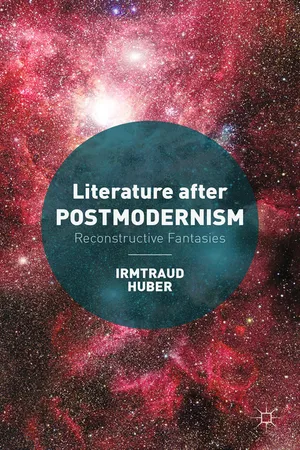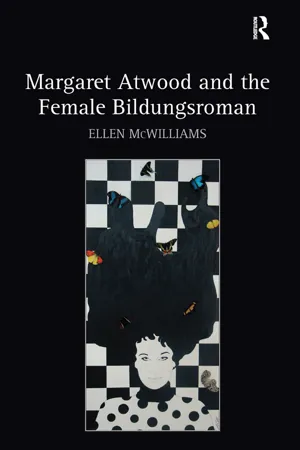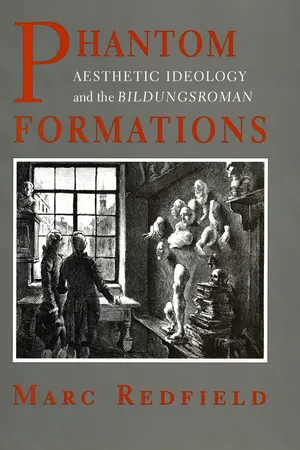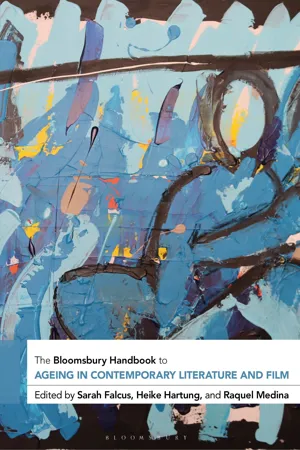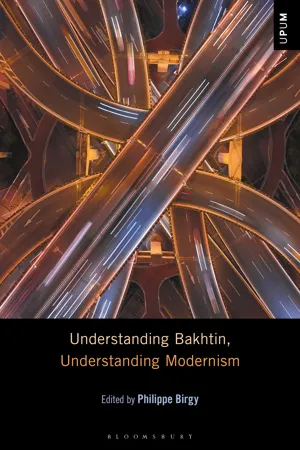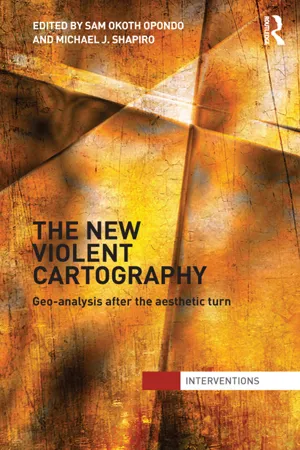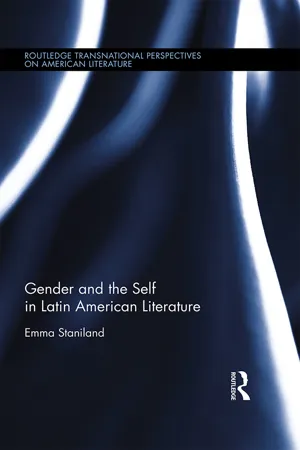Literature
Bildungsroman
Bildungsroman is a literary genre that focuses on the moral and psychological growth of the protagonist from youth to adulthood. It typically involves a coming-of-age story that explores themes of identity, self-discovery, and personal development. The term originated in Germany in the late 18th century.
Written by Perlego with AI-assistance
Related key terms
Related key terms
1 of 4
Related key terms
1 of 3
11 Key excerpts on "Bildungsroman"
- eBook - ePub
Making Homes in the West/Indies
Constructions of Subjectivity in the Writings of Michelle Cliff and Jamaica Kincaid
- Antonia Macdonald-Smythe(Author)
- 2012(Publication Date)
- Routledge(Publisher)
In such novels, authors traced their own experiences and development in the process of combating-or conforming to-their society. This autobiographical material is set within an ostensibly fictionalized framework that removes the work from the realm of the traditional autobiography. (305) The Bildungsroman also maintains the connection between the individual and the society for there is a parallelism between the story narrated and the process of reading it. Martin Swales in The German Bildungsroman from Wieland to Hesse traces this connection to Karl Morgenstern, the earliest architect of the concept of the Bildungsroman as it came into being in the nineteenth century. Morgenstern developing the ideas of Jacob, an earlier theorist, defined the genre thus: It will justly bear the name Bildungsroman, firstly and primarily on account of its thematic material, because it portrays the hi/dung of the hero in its beginnings and growth to a certain stage of completion; and secondly because it is by virtue of this portrayal that it furthers the reader’s bildung to a much greater extent than any other kind of novel. Accordingly, the act of writing serves a larger social purpose. The reader is transformed both by the experiences recorded in the text and by his identification with the protagonist. In the revisioning of the Bildungsroman, West Indian stories of maturation are as much narrative explorations of the artist’s own struggle to define his subjectivity, as they are accounts of the anxiety of West Indian nation to establish themselves as sovereign in the face of imperializing forces. It is this second task which goes beyond the concerns of the European expression of the genre. Further, the West Indian artist establishes himself as the prototypical subject and uses his own experiences as the basis upon which to narrate the development of a wider community - eBook - ePub
Literature after Postmodernism
Reconstructive Fantasies
- I. Huber(Author)
- 2014(Publication Date)
- Palgrave Macmillan(Publisher)
Narrow definitions of the genre developed in German studies insist on restricting it to the very specific context of eighteenth-century Germany, in which the classical idea of Bildung as ‘a harmonious and unified inner culture formed through social freedom and a secular aesthetic education’ took root (Castle 33; cf. Boes 230–3; Swales 14). Nonetheless, the genre has variously seen application within a wider European context (cf. Beddow; Castle; Moretti). Indeed, the Bildungsroman has widely come to figure as the emblematic literary expression of Enlightenment, which, true to Immanuel Kant’s definition of Enlightenment as ‘man’s emergence from his self-imposed immaturity,’ has cast historical development itself as a narrative of formation, imagining it as ‘humanity’s passage to its adult status’ (Foucault 38). Consequently, modernist and postmodernist critiques of the project of Enlightenment also had repercussions on that narrative genre which seemed to owe so many of its basic assumptions to Enlightenment discourses. Contested as the genre and its definition are, Tobias Boes consequently notes a certain critical consensus to ‘regard the novel of formation as a nineteenth-century phenomenon’ (230–1). Although there are some canonical modernist exemplars of the genre, these are often perceived as limit-cases which ultimately attest to the increasing unviability of the typical Bildungsroman trajectory. As Boes summarises a typical critical position: ‘the modernists’ obsession with synchronic models of human experience (epiphany, vortex, shock) and with small-scale diachrony (the stream of consciousness) are often blamed for the demise of a form that by its very definition requires narrative attention to minute and long-term changes’ (231). 2 But the genre became increasingly problematic for more than just aesthetic reasons - eBook - ePub
Human Forms
The Novel in the Age of Evolution
- Ian Duncan(Author)
- 2019(Publication Date)
- Princeton University Press(Publisher)
Bildung, kept open its horizon of universal potentiality.Accordingly, in a taxonomic scandal that has exercised recent criticism, the Bildungsroman seems less to be a clear-cut, stable genre, categorically commensurate with other genres (such as the historical novel), than a principle that pervades the modern novel as such—its “conceptual horizon,” its life force or formative drive.87 Robert Musil identified the Bildungsroman with “the organic plasticity of man”: “In this sense,” he maintained, “every novel worthy of the name is a Bildungsroman.”88 Several commentators emphasize the reverse of this claim: everywhere in novelistic discourse, hence nowhere in particular, the Bildungsroman is a “phantom formation” conjured up by critics.89 In this, again, it models its putative end or product, “humanity,” that horizon of Bildung asymptotic with any actual human life. Schlegel discloses the division, constitutive of the Romantic novel, between a poetic energy or formative drive and a particular form or genre, materialized in a national history that will always fall short of its potential. And he helps us see that division as an anthropological predicament as well as a rhetorical one. Irony is not only the distinctive character or condition of the literary utterance: it is also the condition of being human. Schlegel summarizes the case in an early fragment (parsing Fichte): “humanity is not wholly present in the individual, but there only in part. The human being can never be present.”90 Schlegel, however, construes this human predicament of self-displacement as generative rather than disabling. The force of Schlegelian irony is “expansive and connective, not simply disruptive and corrosive,” since, “though the subject may always be less than it is, it is also more”91 —just as the novel is, or should be, “more than the novel.”92 - eBook - ePub
- Ellen McWilliams(Author)
- 2017(Publication Date)
- Routledge(Publisher)
Perhaps most noticeable is the centrality of ethnicity to the female Bildungsroman, particularly in North American literature. It would seem that in spite of the ideological limitations foregrounded by many critics, the Bildungsroman is destined to remain a medium of expression for new generations of emerging voices, whether in relation to gender and sexuality or to ethnicity and race. Its movement outward in increasing concentric circles from its German origins has made it a truly supranational genre. This book will argue that Atwood’s differences from this recent groundswell in the female genre are as important as her similarities, and yet a brief description of this phenomenon will serve to place Atwood in the context of the genre revitalized far in time and place from its origins.Common to all studies of the multicultural Bildungsroman, whether in the context of Commonwealth, African-Caribbean, Asian, or African-American literatures, is the recognition that, although the Bildungsroman is “a literary form that has outlived its usefulness and become virtually defunct in the European context”, it has assumed “a new and viable identity overseas” (Butcher 261). This is something that is at the centre of Martin Japtok’s comparative reading of the genre in Growing Up Ethnic: Nationalism and the Bildungsroman in African American and Jewish American Fiction (2005), in which he emphasizes the communal dimension of the genre in its new contexts: “What may be called the ethnic Bildungsroman consists, then, of a development away from the more exclusively personality-oriented plot of the traditional Bildungsroman and towards a more political and social vision” (27). Bonnie Hoover Braendlin takes up this theme in her article “Bildung in Ethnic Women Writers”, as does Geta LeSeur in her study Ten is the Age of Darkness: The Black Bildungsroman - eBook - ePub
Phantom Formations
Aesthetic Ideology and the "Bildungsroman"
- Marc Redfield(Author)
- 2018(Publication Date)
- Cornell University Press(Publisher)
Ordinarily we do not think of genres as requiring a model, let alone a visible point of origin; but the Bildungsroman is not an ordinary genre: though all generic terms may be considered aesthetic categories, the Bildungsroman is the genre of aesthetics. In this it differs from a classical genre such as the lyric, for instance, which, for all the aesthetic and ideological investment it has occasioned, bears the traces of multiple and heterogenous histories. The notion of the Bildungsroman, however, has no existence apart from either the post-Romantic history of aesthetics, or the aesthetic formalization that this “genre” takes as its content—in the guise, of course, of the formation of a specific, anthropological subject. 4 As an aesthetic of genre, the Bildungsroman must find embodiment in an example; and the burden of such exemplarity has been assigned to Wilhelm Meisters Lehrjahre ever since Friedrich Schlegel nominated it, with Fichte’s philosophy and the French Revolution, as one of the “greatest tendencies of the age,” and asserted that it was “so thoroughly new and unique” that “only in itself [aus sich selbst] can one learn to understand it.” 5 Schlegel emphasized the text’s power to represent “nature or Bildung itself. . . in manifold examples” (“Über Goethes Meister,” 143); at the same time, however, as we saw, he wrote of “the irony that hovers over the whole work” (137), and told an uncanny story of a text that “judges itself” and “presents itself [stellt sich selbst dar],” yet strangely enough simultaneously fails to judge itself, generating a space for criticism precisely to the extent that its selfrepresentation is “superfluous and incoherent” (134) - Sarah Falcus, Heike Hartung, Raquel Medina, Sarah Falcus, Heike Hartung, Raquel Medina(Authors)
- 2023(Publication Date)
- Bloomsbury Academic(Publisher)
Female characters in these novels typically serve as symbolic representations of the protagonist’s stages of development, culminating in the hero’s harmonious marriage with an idealized woman. The genre’s definition was later broadened to encompass European novels of formation with more realistic settings and plots, including coming-of-age novels by, for instance, Frances Burney, Jane Austen, and George Eliot, about young women whose ‘apprenticeship’ and character formation are confined to domestic settings and the process of courtship (Hirsch 1979 : 308). Their maturation often takes place ‘internally rather than “on the road” ’ (Waxman 1985 : 319). Despite critical tendencies to read these novels as a social critique of women’s limited opportunities (Hartung 2019 : 2), they have also been criticized as showing female characters who ‘grow down’ (Pratt qtd in Waxman 1985 : 319) rather than up. As Heike Hartung claims, ‘These developments within feminist literary history provide the background for reconceptualizations of the Bildungsroman from the perspective of age studies’ (2019 : 2). The cultural narrative of ageing is often presented as a linear ‘decline narrative’ (Gullette 1997); it tends to be marked by one-sided negative stereotypes emphasizing physical and cognitive deterioration, and ultimately marginalizes older people by rendering them socially invisible. In contrast, contemporary versions of the Bildungsroman portray the variety, richness, and complexity of the subjective experience of ageing, ‘extending the notion of individual development to all stages of the life course’ (Hartung 2019 : 3) and focusing on ‘maturity rather than youthfulness as a value’ (2019 : 4)- eBook - ePub
- Jule Selbo(Author)
- 2014(Publication Date)
- Routledge(Publisher)
In literature, a novel that explores a character’s maturation is called a “Bildungsroman”—a German word referring to tales that initially set up an uncomfortable stasis, move into an “education” and finally, an eventual transformation that allows the character to grow into a changed individual. It can be argued that all well-written film narratives have coming-of-age elements for, after all, the protagonist, in most cases, is on a journey of change. He or she “learns” something about self and about the world. However, a screenplay using the coming-of-age genre as an overriding genre must employ certain elements in the plotline and major turning points in the story.Bildungsroman narratives often focus on the psychological and moral development of the character(s) and, in most cases, the journey is interesting because it is challenging and emotional. The protagonist has to literally “shed” a former persona in order to step into new opportunities and sense of self. The change may be marked by a completion of a ritual or a life-changing event or simply by a quiet revelation that alters a person’s attitude or approach to life. Bildungsroman literature includes well-known novels that have been adapted for the screen multiple times: Jane Austen’s Sense and Sensibility (1811) and Pride and Prejudice (1813), Charlotte Brontë’s Jane Eyre (1847), Charles Dickens’ Great Expectations (1861) and Mark Twain’s The Adventures of Huckleberry Finn (1884).The coming-of-age film narrative often emphasizes a progression from childhood to adulthood—thus many “pure” coming-of-age films take place during adolescence.There is an abundance of teen coming-of-age comedies and dramas. Screenwriter and director John Hughes explored the teen coming-of-age film in the 1980s and the actors in these films and others like them became known as the “Brat Pack.” Hughes’ films included box office successes such as The Breakfast Club (1985), Weird Science (1985), Pretty in Pink (1986), Ferris Bueller’s Day Off (1986) and Some Kind of Wonderful (1987). However, coming-of-age stories can be told with characters of any age, from the very young (such as To Kill A Mockingbird (1962), My Girl (1991) and Empire of the Sun (1987)) to characters well into their adulthood years (such as About Schmidt (2002) and Sideways - eBook - ePub
- Philip Brett, Elizabeth Wood, Gary C Thomas, Philip Brett, Elizabeth Wood, Gary C Thomas(Authors)
- 2013(Publication Date)
- Routledge(Publisher)
During this period of radical social transition, many of the concepts we now take for granted as fundamental—such asidentity and masculinity— were still very much in flux. The versions of these concepts we now tend to accept as universal were constructed at this time, in part within the context of the arts: as Terry Eagleton has demonstrated, the aesthetic realm served as one of the principal sites where competing models of the individual and subjectivity could be explored. 17 In literature the privileged genre was the Bildungsroman (roughly translated, the novel of character development) in which a protagonist such as Wilhelm Meister or David Copperfield struggles to learn the ways of the world, to nurture inner resources, to reach maturity. Some of these novels involve female subjects (as in Jane Austen), but the genre more typically concerns the shaping of the new masculine subject. Through such novels, we learn how the proper bourgeois male was to acquire the strength of purpose to forge an autonomous identity, but also to cultivate the sensitivity that made middle-class men worthier than the aristocrats they were displacing. 18 The musical equivalent of the Bildungsroman was not opera, which always remains grounded in social interaction, but rather the seemingly abstract sonata procedure that organizes most classic and romantic instrumental music. 19 Sonata movements, which started to appear in the mid-eighteenth century, typically trace the trajectory of an opening thematic complex that passes through episodes of destabilized identity but arrives finally at the reconsolidation of the original key and theme - eBook - ePub
- Philippe Birgy, Philippe Birgy(Authors)
- 2023(Publication Date)
- Bloomsbury Academic(Publisher)
The history of realism, as it is recounted in the Bildungsroman notes, is remarkably straightforward and progressive. In the beginning, we have prose narratives in which nothing changes: neither the hero (who is often a traveler, an adventurer, or a lover separated from his beloved) nor the world in which the narrative takes place. There follows the earliest version of the Bildungsroman, with roots in classical Greece but maturity only in the Renaissance and Enlightenment, in which “[t]he human being became, but not the world itself” (CW 3 [1937–39]: 331; SG : 23). In this grab-bag of texts from different periods, the heroes strive and change, but this change “took place against the immobile background of a world that is finished and at its foundation completely solid” (ibid.). With Goethe’s appearance, the summit of the form is reached, perhaps a little too soon. Now, as Bakhtin puts it, the hero “becomes together with the world, the historical becoming of the world is reflected in him” (ibid.). In other words, the Modernist conception of historical time that animated the stylistic profile of the modern novel was now embodied in a definite kind of plot; it achieves distinct narrative expression. But historical becoming, as it appears in these notes, acquires a somewhat muted hue: it is exemplified in the transition from one historical era to another (the hero is posed “on the border between two epochs, at the point of transition from one to the other” (ibid.), as if Bakhtin had incorporated Stalinism’s notorious “stagist” view of historical change into his conception. There is transformation, but it seems to lack the abruptness and unpredictability we find later. If this was some kind of compromise, it didn’t last long. By the middle of the text, Bakhtin has a new concept, the chronotope, and a new literary exemplar, Rabelais - eBook - ePub
The New Violent Cartography
Geo-Analysis after the Aesthetic Turn
- Samson Opondo, Michael Shapiro(Authors)
- 2012(Publication Date)
- Routledge(Publisher)
3 Postcolonial writers are of course conversant with the challenge of ‘oppositional criticism’ and with the risks of becoming coopted by the dominant forms and cultural discourses of Western Liberalism (Ahluwalia, 2007). In reading this particular novel, we can identify what might be involved in the broader challenge of formulating critical resistance to the heightened nationalism of the War on Terror.A nationalist imaginary extends much further than the spatial differentiations of ‘us’ and ‘them’; it is also animated by a particular understanding of freedom, which is expressed in the particular genre of the Bildungsroman (Cheah, 2003). This is the modern idea that we are autonomous individuals, in charge of our own destinies, capable of overcoming the burdens of the past and becoming more and more enlightened. It is a ‘conception of freedom that is understood to emerge through time, and which is temporally progressive in its structure’ (Butler, 2008, page 3). significantly, this time of progress is understood as potentially restorative of something that has been lost and needs to be regained in the future. In the Bildungsroman , that which is understood to be lost or broken is the connection between the main protagonist and the world, which sends him (originally, predominantly, but not exclusively a ‘him’) on a search for meaning, moral purpose, or a relationship that can ease this broken bond of modernity. The Bildungsroman therefore mirrors the nation in that both seek to offer an antidote to modernity’s upheavals (Cheah, 2003, page 243). In the context of this particular novel, the idea of restoring this ‘broken’ bond emerges in Changez’s relationship with his occasional girlfriend, Erica (a play on AmErica). We hear that Erica is initially drawn to Changez because of his strong sense of home. She is searching for some roots, stability and a stable core, and she identifies those qualities with Changez. When Changez can’t in the end secure Erica’s love, he blames it on the fact that he doesn’t really know where he belongs: in America or in Pakistan. Following in the trajectory of the Bildungsroman - eBook - ePub
- Emma Staniland(Author)
- 2015(Publication Date)
- Routledge(Publisher)
The first, and for me most intriguing, of the commonalities between the Post-Boom novel and the classical Bildungsroman is their inception in revolutionary contexts. The Post-Boom writers’ generational identity derives in large part from their having been inspired to develop ‘a sense of a different relationship between fiction and its sociopolitical context’ by the political atrocities of the 1970s and 1980s; decades scarred by authoritarian regimes, human rights abuses of horrifying proportions, and guerrilla warfare. 52 In essence, then, the Post-Boom came to life just as the Bildungsroman did: at a time when social shifts necessitated new understandings of the relationship between the individual and their social context. It is therefore perhaps not surprising, but nonetheless compelling, that the genre and the movement also come to share ideological interests expressed in their thematic focus: the articulation of new kinds of selfhood. Of especial relevance to this project is the fact that the Post-Boom’s answer to the Bildungsroman’s then radical introduction of the white middle class bourgeois voice, 53 was the introduction of a female literary voice and the portrayal of female experiences of life in the region; what Uruguayan writer Ángel Rama famously referred to as the ‘great eruption of women writers’ that has come to be recognized as one of the wave’s major characteristics, 54 and a change whose ‘powerful’ value Argentine Post-Boom writer Mempo Giardinelli reflected on in a lecture delivered at the Americas Society in 1994, remarking: I do not believe in feminine or feminist literature (literature has no sex), but I think that one of the most noteworthy and original aspects of Latin American literature is the sudden materialization of a remarkable generation of writing women
Index pages curate the most relevant extracts from our library of academic textbooks. They’ve been created using an in-house natural language model (NLM), each adding context and meaning to key research topics.
Explore more topic indexes
Explore more topic indexes
1 of 6
Explore more topic indexes
1 of 4

